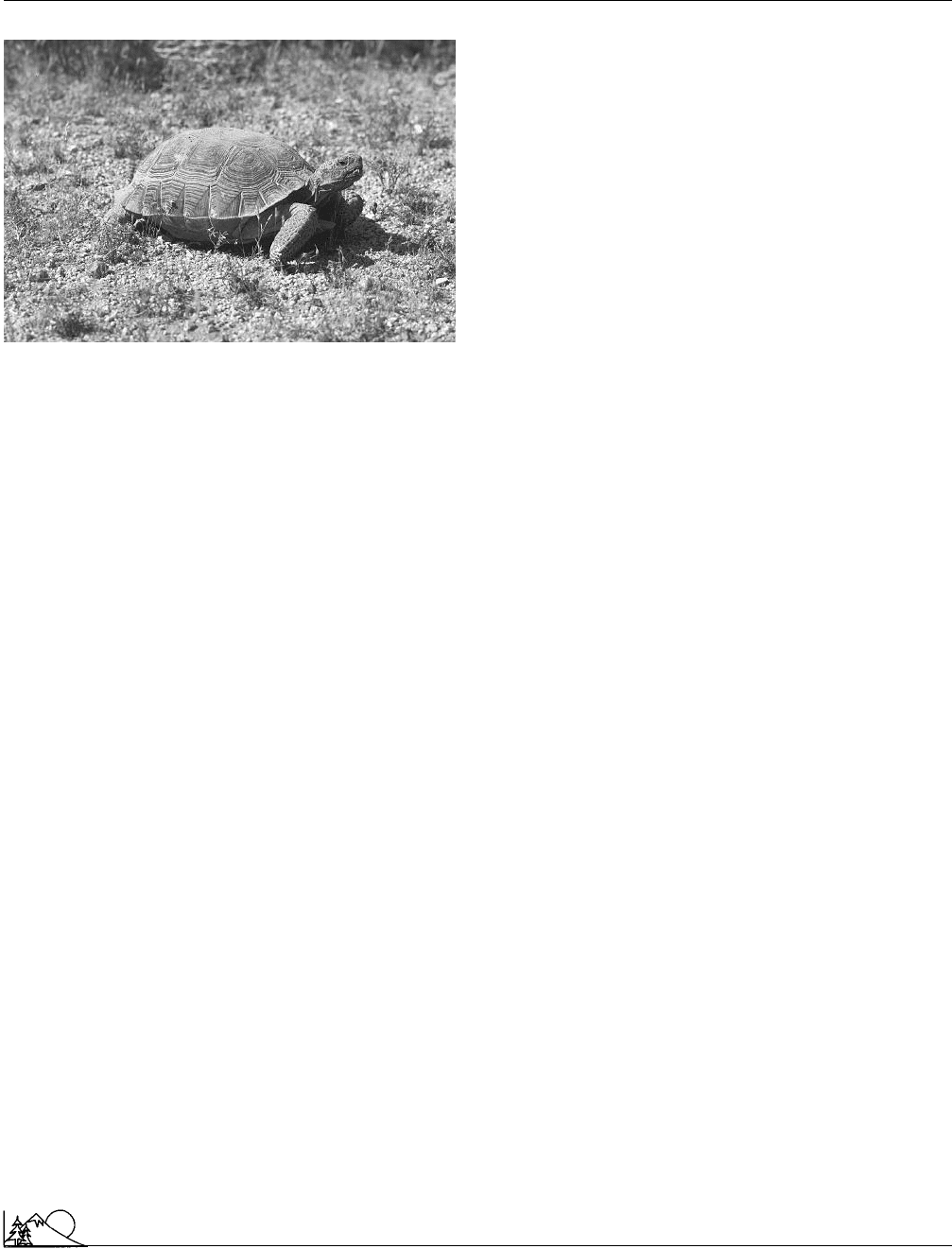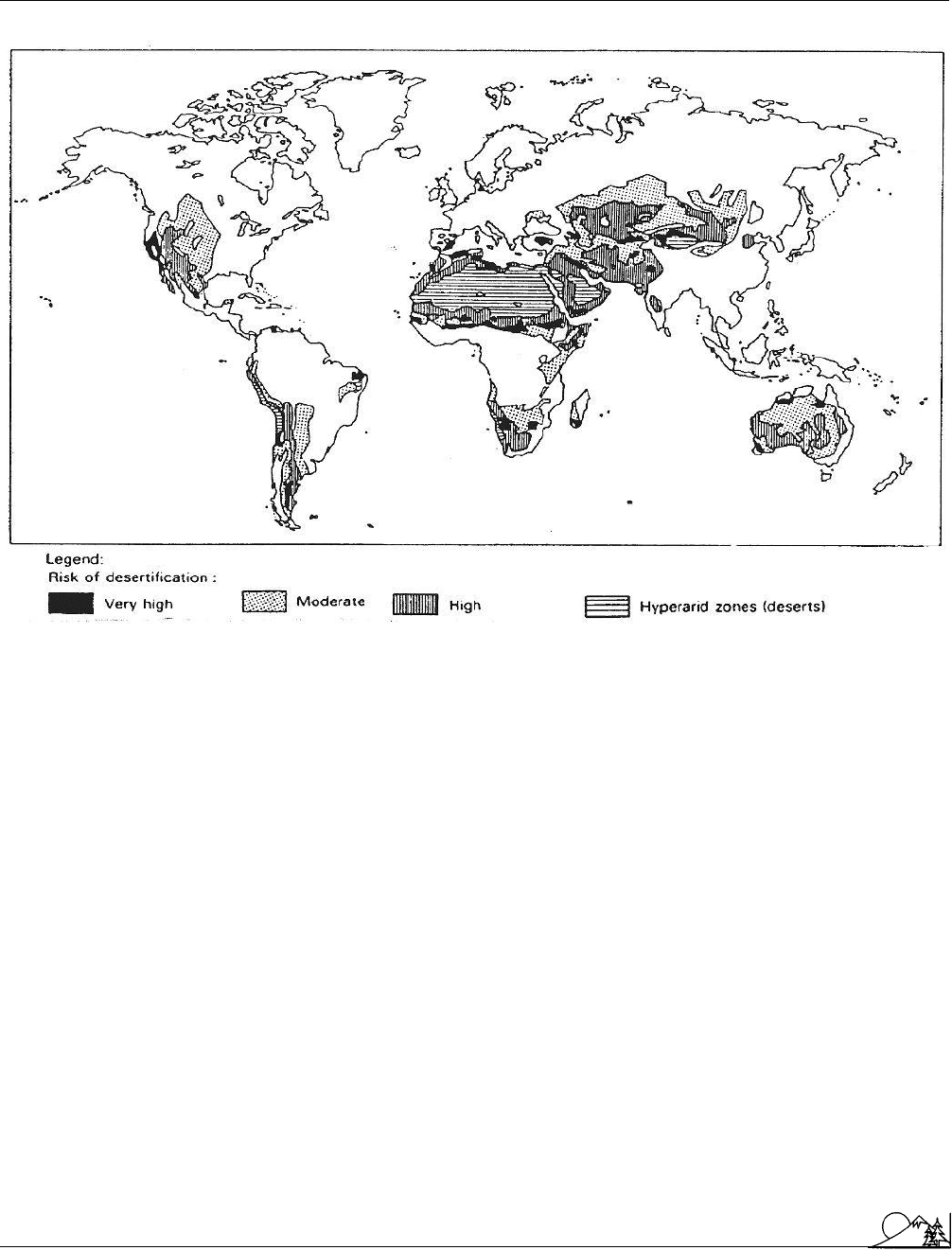Environmental Encyclopedia
Подождите немного. Документ загружается.


Environmental Encyclopedia 3
Defoliation
Defenders of Wildlife
Defenders of Wildlife was founded in 1947 in Washington,
D.C. Superseding older groups such as Defenders of Furbear-
ers and the Anti-Steel-Trap League, the organization was es-
tablished to protect wild animals and the habitats that support
them. Today their goals include the preservation of
biodiver-
sity
and the defense of
species
as diverse as gray
wolves
(Canis lupus),
Florida panthers
(Felis concolor coryi), and griz-
zly bears (Ursus arctos), as well as the western yellow-billed
cuckoo (Coccyzus americanus), the
desert tortoise
(Gopherus
agassizii), and Kemp’s Ridley sea turtle (Lepidochelys kempii).
Defenders of Wildlife employs a wide variety of meth-
ods to accomplish their goals, from research and education
to lobbying and litigation. They have achieved a ban on
livestock grazing on 10,000 acres (4,050 ha) of tortoise
habi-
tat
in Nevada and lobbied for restrictions on the interna-
tional wildlife trade to protect
endangered species
in other
countries. In 1988 they successfully lobbied Congress for
funding to expand wildlife refuges throughout the country.
Ten million dollars was appropriated for the Lower Rio
Grande
National Wildlife Refuge
in Texas, two million
dollars to purchase land for a new preserve along the Sacra-
mento River in California, and $1 million for additions to
the Rachel Carson National
Wildlife Refuge
in Maine.
They are currently seeking passage of the National Biological
Diversity Conservation and Research Act and the American
Heritage Trust Fund, which would support the continued
acquisition of natural habitats.
The organization has been at the forefront of placing
preservation on an economic foundation. In Oregon, they
have overseen the establishment of a number of areas from
which to view wildlife on public and private land, thus im-
proving access to natural habitats and linking the
environ-
ment
with the economic benefits of the state’s tourism in-
dustry. Defenders maintains a speaker’s bureau, and they
support a number of educational programs for children de-
signed to nourish and expand their interest in wildlife. But
the group also participates in more direct action on behalf
of the environment. They coordinate grassroots campaigns
through their Defenders Activist Network, which has a
membership of 9,000. They work with the
Environmental
Protection Agency
on a hotline called the “Poison Patrol,”
which receives calls on the use of pesticides that damages
wildlife, and they belong to the Entanglement Network Coali-
tion, which works to prevent the loss of animal life through
entanglement in nets and plastic refuse.
Restoring wolves to their natural habitats has long
been one of the top priorities of Defenders of Wildlife. In
1985, they sponsored an exhibit in
Yellowstone National
Park
and at Boise, Idaho, called “Wolves and Humans,”
which received over 250,000 visitors and won the
Natural
357
Resources
Council of America Award of Achievement for
Education. They have helped reintroduce red and gray
wolves back into the northern Rockies. In order to assist
farmers and the owners of livestock herds that graze in these
areas, Defenders has raised funds to compensate them for the
loss of land. They are also working to reduce and eventually
eliminate the
poisoning
of predators, both by lobbying for
stricter legislation and by encouraging Western farmers to
participate in their guard dog program for livestock.
In order to conserve land, the Defenders have also
launched their own coffee line called “Java Forest.” The
coffee beans are grown under the forest canopy or on farms
which recreate a natural habitat. This reduces the large
amount of land that is used for hybrid coffee beans. Twenty-
five percent of each purchase is being returned to the De-
fenders to be used in other programs.
Defenders of Wildlife has 425,000 members and an
annual budget of $5.2 million. In addition to wildlife viewing
guides for different states, their publications include a bi-
monthly magazine for members called Defenders and In De-
fense of Wildlife: Preserving Communities and Corridors..
[Douglas Smith]
R
ESOURCES
O
RGANIZATIONS
Defenders of Wildlife, 1101 14th Street, NW #1400, Washington, D.C.
USA 20005 (202) 682-9400, Email: info@defenders.org, <http://
www.defenders.org>
Defoliation
Several factors can cause a plant to lose its leaves and become
defoliated. Defoliation is a natural and regular occurrence
in the case of deciduous trees and shrubs that drop their
leaves each year with the approach of winter. This process
is aided by an abscission layer that develops at the base of
the leaf petiole, weakens the attachment to the plant, and
eventually causes the leaf to drop. Severe
drought
may also
cause leaves to wilt, dry and drop from a plant. The result
of severe dehydration is usually lethal for herbaceous plants,
although some woody
species
may survive an episode of
drying. Heavy infestation by leaf-eating insects can lead to
partial, or complete defoliation. The
gypsy moth
(Porthetria
dispar) is an important defoliator that attacks many trees,
defoliating, and weakening, or killing them. Parasitic wasps
that feed on the larvae can help to control gypsy moth
outbreaks. Insecticide sprays have also be used to kill the
larvae. Spider mites, any of the plant-feeding mites of the
family Tetranychidae (subclass Acari), feed on house plants
and the foliage and fruit of orchard trees. Heavy infestation
can lead to serious or complete defoliation. Spider mites are

Environmental Encyclopedia 3
Deforestation
controlled with pesticides, although growing
resistance
to
chemical control agents has made this more difficult, and
alternative control measures are under investigation.
Along with natural causes of defoliation,
chemicals
can cause plants to drop their leaves. The best known and
most widely used chemical defoliators are 2,4,5 trichlorophe-
noxyacetic
acid
(
2,4,5-T
) and 2,4 dichlorophenoxyacetic
acid (
2,4-D
). Both chemicals are especially toxic to broad-
leaf plants. The
herbicide
2,4-D is widely used in lawn care
products to rid lawns of dandelions, clover, and other broad-
leaf plants that interfere with robust turf development. At
appropriate application rates, it selectively kills broad-leaf
herbaceous plants, and has little effect on narrow-leaf grasses.
The uses of 2,4,5-T are similar, although it has been more
widely used against woody species.
A mixture of 2,4-D and 2,4,5-T, in a product called
Agent Orange
has been extensively used to control the
growth and spread of woody trees and shrubs in sites ear-
marked for industrial or commercial development. Agent
Orange saw extensive use by American forces in Southeast
Asia during the Vietnam war, where it was used initially to
clear for power lines, roads, railroads, and other lines of
communication. Eventually, as the war continued, it was
used to spray enemy hiding places, and U.S. military base
perimeters to prevent surprise attack. Food crops, especially
rice, were also targets for Agent Orange to deprive enemy
forces of food. Although Agent Orange and other formula-
tions containing the chlorinated phenoxy acetic acid deriva-
tives are generally lethal to herbaceous plants, woody decidu-
ous plants may survive one or more treatments, depending
on the species treated, concentrations used, spacing of appli-
cations, and weather. In Vietnam it was found that mangrove
forests in the Mekong delta were especially sensitive, and
often killed by a single treatment. A member of the
dioxin
family of chemicals, 2,3,7,8-tetrachlorodibenzo-p-dioxin
(TCDD) has been found to be an accidental but common
contaminant of 2,4,5-T and Agent Orange. Dioxins are very
resistant to attack by
microbes
in the
environment
, and
are apt to persist in soils for a very long time. Although
few disorders have been definitively proven to be caused by
dioxins, their effects on laboratory animals have caused some
scientists to rank them among the most poisonous substances
known. The U.S. government banned some 2,4,5-T con-
taining products in 1979 because of uncertainties regarding
its safety, but its use continues in other products.
[Douglas C. Pratt Ph.D.]
R
ESOURCES
B
OOKS
Addicott, F. T. Abscission. Berkeley: University of California Press, 1952.
Gansner, D. A. Defoliation potential of gypsy moth. Radnor, Pa.: U.S. Dept.
of Agriculture, Northeastern Forest Experiment Station, 1993.
358
Teas, H. J. Herbicide toxicity in mangroves. U.S. Environmental Protection
Agency, Office of Research and Development, Environmental Research
Laboratory, Springfield Va.: for sale by the National Technical Information
Service, 1976.
Whiteside, T. The withering rain; Americas herbicidal folly. New York:
Dutton, 1971.
Deforestation
Deforestation is the complete removal of a forest
ecosystem
and conversion of the land to another type of landscape. It
differs from
clear-cutting
, which entails complete removal
of all standing trees but leaves the
soil
in a condition to
regrow a new forest if seeds are available. Humans destroy
forests for many reasons. American Indians burned forests
to convert them to
grasslands
that supported big game
animals. Early settlers cut and burned forest to convert them
to croplands. Between 1600 to 1909, European settlement
decreased forest cover in the United States by 30%. Since that
time, total forest acreage in the United States has actually
increased. In Germany about two-thirds of the forest was
lost through settlement. Food and Agriculture Organization
(FAO) estimated that from 1980 to 1990, 0.9% of remaining
tropical forests were deforested annually (65,251 mi
2
[169,000 km
2
] per year), an area equivalent to the state of
Washington. FAO defines forest as land with more than
10% tree cover, natural understory vegetation,
nature
ani-
mals, natural soils, and no agriculture. Analysis of deforesta-
tion is difficult because data is unreliable and the definitions
for “forest” and “deforestation” keep changing; for example,
clear-cuttings which reforest within five years have been
considered deforested in some studies but not in others.
The major direct causes of topical deforestation are
the expansion of shifting agriculture, livestock production,
and fuelwood harvest in drier regions. Forest conversion to
permanent cropland, infrastructure, urban areas, and com-
mercial fisheries also occurs. Although not necessarily re-
sulting in deforestation, timber harvest, grazing, and fires
can severely degrade the forest. The environmental costs
of deforestation can include
species extinction
,
erosion
,
flooding
, reduced land productivity,
desertification
, and
climate
change and increased atmospheric
carbon dioxide
.
As more
habitat
is destroyed, more species are facing extinc-
tions. Deforestation of watersheds causes erosion, flooding,
and
siltation
. Upstream land loses fertile
topsoil
and down-
stream crops are flooded, hydroelectric reservoirs are filled
with
silt
and fisheries are destroyed. In drier areas, deforesta-
tion contributes to desertification.
Deforestation can alter local and regional climates be-
cause evaporation of water from leaves makes up as much
as two-thirds of the rain that falls in some forest. Without
trees to hold back surface
runoff
and block wind, available
moisture is quickly drained away and winds dry the soil,

Environmental Encyclopedia 3
Delaney Clause
sometimes resulting in desert-like conditions. Another po-
tential effect on climate is the large scale release into the
atmosphere
of
carbon
dioxide stored as organic carbon in
forests and forest soils. In 1980, tropical deforestation re-
leased between 0.4 and 1.6 billion tons of carbon into the
atmosphere, an amount equal to 10–40% of that from
fos-
sil fuels
.
As a result of misguided deforestation in the moist
and dry tropics, the rural poor are deprived of construction
materials, fuel, food, and cash crops harvested from the
forest. Species extinctions, siltation, and flooding expand
these problems to national and international levels. Despite
these human and environmental costs, wasteful deforestation
continues. Current actions to halt and reverse deforestation
focus on creating economic and social incentives to reduce
wasteful land conversion by providing for wiser ways to
satisfy human needs. Other efforts are the reforestation of
deforested areas and the establishment and maintenance of
biodiversity
preserves.
[Edward Sucoff]
R
ESOURCES
B
OOKS
Rowe, R., N. P. Sharma, and J. Browder. “Deforestation: Problems, Causes
and Concerns.” In Managing the World’s Forests, edited by N. P. Sharma.
Dubuque, IA: Kendall Hunt, 1992.
P
ERIODICALS
Monastersky, R. “The Deforestation Debate.” Science News 144 (July 10,
1993): 26-27.
Delaney Clause
The Delaney Clause is a part of the Federal Food, Drug,
and Cosmetic Act of 1958, Section 409, and it prohibits
the addition to food of any substance that will cause
cancer
in animals or humans. The clause states “no additive will
be deemed to be safe if it is found to induce cancer when
ingested by man or animal, or if it is found, after tests which
are appropriate for the evaluation of the safety of
food
additives
, to induce cancer in man or animals...” The clause
addresses the safety of food intended for human consump-
tion and few, if any, reasonable individuals would argue with
its intent.
There is however, an emerging scientific controversy
over its application, and many now question the merits of the
clause as it is written. For example, safrole occurs naturally as
a constituent in sassafras tea and spices and thus permissibly
under the Delaney Clause, but it is illegal and banned as an
additive to natural root beer because it has been proven a
359
carcinogen
in animal tests. Coffee is regularly consumed
by many individuals, yet more than 70% of the tested
chemi-
cals
that occur naturally in coffee have been shown to be
carcinogenic in one or more tests. Naturally occurring carcin-
ogens are found in other foods including lettuce, apples,
pears, orange juice, and peanut butter. It is important to
note here that the National Cancer Institute recommends
the consumption of fruits and vegetables as part of a regimen
to reduce cancer risk. This is because it is widely believed
that the positive effects of fruits and vegetables far outweigh
the potential hazard of trace quantities of naturally occurring
carcinogens.
It has been estimated that about 10,000 natural pesti-
cides of plants are consumed in the human diet. These
natural pesticides protect the plants from disease and preda-
tion by other organisms. Only a few of these natural plant
pesticides (less than 60) have been adequately tested for
carcinogenic potential and of these about half of them tested
positive. Bruce N. Ames and his associates at the University
of California estimate that 99.99% of the pesticides ingested
by humans are not residues of chemicals applied by humans
but are chemicals that occur naturally and therefore legally.
It has been argued that such naturally occurring chemicals
are less hazardous and thus differ in their cancer-causing
potential from synthetic chemicals. But this does not appear
to be the case; although the mechanisms for chemical carci-
nogenesis are poorly understood, there seems to be no funda-
mental difference in how natural and synthetic carcinogens
are metabolized in the body.
The Delaney Clause addresses only the issue of addi-
tives to the food supply. It is noteworthy that salt, sugar,
corn syrup, citric
acid
and baking soda comprise 98% of the
additives listed, while chemical additives, which many fear,
constitute only a small fraction. It should also be noted that
there are other significant safety issues pertaining to the food
supply, including pathogens which cause botulism, hepatitis,
and salmonella food
poisoning
. Of similar concern to health
are traces of environmental pollutants, such as
mercury
in
fish, and cooking-induced production of carcinogens, such
as
benzopyrene
in beef cooked over an open flame. Excess
fat in the diet is also thought to be a significant health
hazard.
Scientists who are rethinking the significance of the
“zero risk” requirement of the Delaney Clause do not believe
society should be unconcerned about chemicals added to
food. They simply believe the clause is no longer consistent
with current scientific knowledge, and they argue that chem-
icals added in trace quantities, for worthwhile reasons, should
be considered from a different perspective. See also Agricul-
tural chemicals; Agricultural pollution; Drinking-water sup-
ply; Food and Drug Administration
[Robert G. McKinnell]

Environmental Encyclopedia 3
Demographic transition
R
ESOURCES
P
ERIODICALS
Corliss, J. “The Delaney Clause: Too Much of a Good Thing?” Journal of
the National Cancer Institute 85 (1993): 600-603.
Gold, L. S., et al. “Rodent Carcinogens: Setting Priorities.” Science 258 (9
October 1992): 261-265.
Demographic transition
Developed by demographer Frank Notestein in 1945, this
concept describes the typical pattern of falling death and
birth rates in response to better living conditions associated
with economic development. This idea is important, for it
offers the hope that developing countries will follow the
same pathway to population
stability
as have industrialized
countries. In response to the Industrial Revolution, for exam-
ple, Europe experienced a population explosion during the
nineteenth century. Emigration helped alleviate overpopula-
tion, but European couples clearly decided on their own to
limit family size.
Notestein identified three phases of demographic tran-
sition: preindustrial, developing, and modern industrialized
societies. Many authors add a fourth phase, postindustrial.
In phase one, birth rates and death rates are both high with
stable populations. As development provides a better food
supply and
sanitation
, death rates begin to plummet, mark-
ing the onset of phase two. However, birth rates remain
high, as families follow the pattern of preceding generations.
The gap between high birth rates and falling death rates
produces a population explosion, sometimes doubling in less
than 25 years.
After one or two generations of large, surviving fami-
lies, birth rates begin to taper off, and as the population
ages, death rates rise. Finally a new balance is established,
phase three, with low birth and death rates. The population
is now much larger yet stable. The experience of some Euro-
pean countries, especially in Central Europe and Russia,
suggests a fourth phase where populations actually decline.
This may be a response to past hardships and oppressive
political systems there, however.
Historically, birth rates have always been high. With
few exceptions population explosions are linked to declining
death rates, not rising birth rates. Infants and young children
are especially vulnerable; sanitation and proper food are vital.
Infant survival is seen by some as a threat because of the built-
in momentum for
population growth
. However, history
reveals that there has been no decline in birth rates which
has not been preceded by a drop in infant
mortality
.Ina
burgeoning world this makes infant survival a matter of top
priority. To this end, in 1986 the United Nations adopted
a program with the acronym GOBI: Growth monitoring,
Oral rehydration therapy (to combat killer diarrhea), Breast
360
feeding, and Immunization against major
communicable
diseases
. See also Child survival revolution; Population
Council
[Nathan H. Meleen]
R
ESOURCES
B
OOKS
Cunningham, W. P., and B. W. Saigo. Environmental Science: A Global
Concern. 2nd ed. Dubuque, IA: William C. Brown, 1992.
Maddox, J. The Doomsday Syndrome. New York: McGraw-Hill, 1972.
P
ERIODICALS
Keyfitz, N. “The Growing Human Population.” Scientific American 261
(September 1989): 7-16.
Dendroica kirtlandii
see
Kirtland’s warbler
Denitrification
A stage in the
nitrogen cycle
in which
nitrates
in the
soil
or in dead organic matter are converted into nitrite,
nitrous
oxide
, ammonia, or (primarily) elemental
nitrogen
. The
process is made possible by certain types of bacteria, known
as denitrifying bacteria. Denitrification is a reduction reac-
tion and occurs, therefore, in the absence of oxygen. For
example, flooded soil is likely to experience significant deni-
trification since it is cut off from atmospheric oxygen. Al-
though denitrification is an important process for the decay
of dead organisms, it can also be responsible for the loss of
natural and synthetic fertilizers from the soil.
Deoxyribose nucleic acid
Deoxyribose
nucleic acid
(DNA) molecules contain genetic
information that is the blueprint for life. DNA is made
up of long chains of subunits called nucleotides, which are
nitrogenous bases attached to ribose sugar molecules. Two of
these chains intertwine in the famous double helix structure
discovered in 1953 by James Watson and Francis Crick.
The genetic information contained in DNA molecules
is in a code spelled out by the linear sequence of nucleotides
in each chain. Each group of three nucleotides makes up a
codon, a unit resembling a letter in the alphabet. A string
of codons effectively spells a word of the genetic message.
This message is expressed when enzymes (cellular pro-
teins) synthesize new proteins using a copy of a short segment
of DNA as a template. Each nucleotide codon specifies
which amino
acid
subunit is inserted as the protein is
formed, thus determining the structure and function of the

Environmental Encyclopedia 3
Desalinization
proteins. Because the chains are very long, a single DNA
strand can contain enough information to direct the synthesis
of hundreds of different proteins. Since these proteins make
up the cell structure and the machinery (enzymes) by which
cells carry out the processes of life, such as synthesizing more
molecules including more copies of the DNA itself, DNA
can be said to be self-replicating. When cells divide, each
of the new cells receives a duplicate set of DNA molecules
giving them the necessary information to live and reproduce.
See also Ribosenucleic acid
Department of Agriculture
see
U.S. Department of Agriculture
Department of Energy
see
U.S. Department of Energy
Department of Health and Human
Services
see
U.S. Department of Health and
Human Services
Department of the Interior
see
U.S. Department of the Interior
Desalinization
Desalinization, also known as “desalination,” is the process
of separating sea water or
brackish
water from their dis-
solved salts. The average salt content of the ocean water is
about 3.4% (normally expressed as 34 parts per thousand).
The range of salt content varies from 18 parts per thousand
in the North Sea and near the mouths of large rivers to a
high of 44 parts per thousand in locked bodies of water
such as the Red Sea, where evaporation is very high. The
desalination process is accomplished commercially by either
distillation or reverse osmosis (RO).
Distillation of sea water is accomplished by boiling
water and condensing the vapor. The components of the
distillation system consist of a boiler and a condenser with
a source of cooling water. Reverse osmosis is accomplished
by forcing filtered sea water or brackish water through a
reverse osmosis membrane. In a reverse osmosis process,
approximately 45% of the pressurized sea water goes through
membranes and becomes fresh water. The remaining brine
(concentrated salt water) is returned to the sea.
361
In 1980, the United Nations declared 1981–1990 as
the “International Drinking Water Supply and
Sanitation
Decade.” The objective was to provide safe drinking water
and sanitation to developing nations. Despite some progress
in India, Indonesia, and a few other countries, the percentage
of the world population with access to safe drinking water
has not changed much since that declaration. In the period
between 1990 and 2000, the amount of people with access
has only increased by 5%.
The World Health Organization (WHO) estimates
that only two in five people in the
less developed countries
(LDCs) have access to safe drinking water. The WHO also
estimates that at least 25 million people of the LDCs die
each year because of polluted water and from water-born
diseases such as
cholera
, polio, dysentery, and typhoid.
Whether by distillation or by reverse osmosis, desalination
of water can transform water that is unusable because of its
salinity
into valuable fresh water. This could be an important
water source in many drought-prone areas.
Desalination plants, distribution, and functions
There are approximately 7,500 desalination plants
worldwide. Collectively they produce less than 0.1% of the
world’s fresh water supply. This supply is equal to about 3.5
billion gal per day (13 million l). The cost and the feasibility
of producing desalinated water depends upon the cost of
energy, labor, and relative costs of desalinated water to that
of imported fresh water. It is estimated that in the United
States, commercial desalinated water produced from sea
water by reverse osmosis costs about $3 per 1,000 gal (3,785
l). This price is four to five times the average price currently
paid by urban consumers for drinking water and over 100
times the price paid by farmers for
irrigation
water. The
current energy requirement is approximately three kilowatt
hours of electricity per one gallon of fresh water extracted
from sea water. Currently, using desalinated water for agri-
culture is cost prohibitive.
About two-thirds of the desalination water is produced
in Saudi Arabia, Kuwait, and North Africa. Several small-
scale reverse osmosis plants are now operating in the United
States, including California (Santa Barbara, Catalina Island,
and soon in Ventura and other coastal communities). Gener-
ally, desalination plants are used to supplement the existing
fresh water supply in areas adjacent to oceans and seas such
as southern California, the Persian Gulf region, and other
dry coastal areas. Among the advantages of desalinized water
are a dependable water supply regardless of rainfall patterns,
elimination of
water rights
disputes, and the preservation
of the fresh water supply, all of which are essential for existing
natural ecosystems.
Reverse osmosis
Reverse osmosis involves forcing water under pressure
through a
filtration
membrane that has pores small enough

Environmental Encyclopedia 3
Desert
to allow water molecules to pass through but exclude slightly
larger dissolved salt molecules. The basic parts of a reverse
osmosis system include onshore and offshore components.
The onshore components consist of a water pump, an electri-
cal power source, pre-treatment filtration (to remove sea-
weed and debris), reverse osmosis units connected in series,
solid waste
disposal equipment, and fresh water pumps.
The offshore components consist of an underwater intake
pipeline, approximately 1,093 yd (1 km) from shore, and a
second pipeline for brine
discharge
.
Small reverse osmosis units for home use with a few
gallons-per-day capacity are available. These units use a
disposable reverse osmosis membrane. Their main drawback
is that they waste four to five times the volume of water
they purify.
Producing potable water from sea water is an energy
intensive, costly process. The high cost of producing desali-
nized water limits its use to domestic consumption. In areas
such as the Persian Gulf and Saudi Arabia where energy is
plentiful at a low cost, desalinized water is a viable option
for drinking water and very limited greenhouse agriculture.
The notion of using desalinized water for wider agricultural
purposes is neither practical nor economical at today’s energy
prices and available technology.
[Muthena Naseri]
R
ESOURCES
B
OOKS
Kaufman, D. G., and C. M. Franz. Biosphere 2000: Protecting Our Global
Environment. New York: Harper-Collins, 1993.
Nebel, B. J., and R. T. Wright. Environmental Science: The Way the World
Works. 4th Edition. Englewood Cliffs, NJ: Prentice Hall, 1993.
O
THER
Lizarraga, S., and D. Brown. “Fresh Water from Santa Barbara Seas.”
Reprinted from Desalination and Water Reuse, 1992. Santa Barbara: Depart-
ment of Water Resources.
Desert
Six percent of the world’s land surface is desert, a
biome
in
which less than 10 in (25 cm) of precipitation occurs per year
or any place where evaporation greatly exceeds precipitation,
resulting in a lack of available moisture. Sometimes any area
lacking the necessary conditions to support life is called a
desert. Deserts occur around latitudes 30 degrees north and
south where masses of dry circulating air descend to the
earth’s surface. There are three kinds of deserts—hot (such
as Sahara), temperate (such as the Mojave), and cold (such
as the Gobi). The area of global desert is increasing yearly,
as marginal lands become degraded by human misuse re-
sulting in
desertification
. Deserts are potential sites for the
362
production of electricity using banks of solar cells or parabolic
solar collectors. The lack of water and remoteness of some
deserts may make them attractive places to store nuclear and
other hazardous wastes.
Desert tortoise
The
desert
tortoise (Gopherus agassizii) is a large, herbivo-
rous, terrestrial turtle of the family Testudinidae. It is found
in both the southwestern United States and in northwestern
Mexico. It is the official reptile in the states of California
and Nevada. No other turtle in North America shares the
extreme conditions of the habitats occupied by the desert
tortoise. It inhabits desert oases, washes, rocky hillsides, and
canyon bottoms with sandy or gravelly
soil
under hot,
arid
conditions.
Desert tortoises dig into dry, gravelly soil under bushes
in arroyo banks or at the base of cliffs to construct a burrow,
which is their home. Climatic conditions dictate daily activ-
ity patterns of these tortoises, and they can relieve the prob-
lems of high body temperature and evaporative water loss
by retreating into their burrows. Since many desert tortoises
live in areas devoid of water, except for infrequent rains,
they must rely on their food for their water.
The active period for the desert tortoise is from March
through September, after which they enter a hibernation
period. Nesting and egg laying activities extend from May
through July. Desert tortoises lay an average of five moisture-
proof eggs, an
adaptation
that helps retain water in its
harsh
environment
. These tortoises reach sexual maturity
at 15–20 years, and they have a life span of up to 80 years.
The desert tortoise is very sensitive to human distur-
bances, and this has led to the decimation of many of its
populations throughout the desert southwest. The Beaver
Dam Slope population of southwestern Utah has been stud-
ied over several decades and shows some of the general
tendencies of the overall population. In the 1930s and 1940s
the desert tortoise population in this area exhibited densities
of about 160 adults per square mile. By the 1970s this density
had fallen to less than 130 adults per square mile, and more
recent studies indicate the level is now about 60 adults per
square mile. In southeastern California at least one popula-
tion reaches densities of 200 adults per square mile, but
overall tendencies show that populations are drastically de-
clining. Recent estimates indicate that there are about
100,000 individual desert tortoises existing in the Mojave
and Sonoran deserts.
Desert tortoise populations are listed as threatened in
Arizona, California, Nevada, and Utah. Numerous factors
are contributing to its decline and vulnerability.
Habitat
loss
through human encroachment and development, overcol-

Environmental Encyclopedia 3
Desertification
A desert tortoise in the Desert Tortoise Natural
Area, Mojave Desert, California. (Photograph by
Dan Suzio. Reproduced by permission.)
lecting for the
pet trade
, and vandalism—including shoot-
ing tortoises for target practice and flipping them over onto
their backs, causing them to die from exposure—have deci-
mated populations. Other factors contributing to their de-
cline are grazing livestock, which trample them or their
burrows, and mining operations, which also causes respira-
tory infections among the desert tortoises. Numerous desert
tortoises have been killed or maimed by
off-road vehicles
,
which also collapse the tortoises’ burrows. Concern is
mounting as
conservation
efforts seem to be having little
effect throughout much of the desert tortoise’s range.
[Eugene C. Beckham]
R
ESOURCES
B
OOKS
Campbell, F. “The Desert Tortoise.” Audubon Wildlife Report. San Diego:
Academic Press, 1988–89.
Ernst, C., and R. Barbour. Turtles of the United States. Lexington: University
Press of Kentucky, 1972.
———. Turtles of the World. Washington, DC: Smithsonian Institute
Press, 1989.
Desertification
About one billion people live in
arid
or semiarid
desert
lands that occupy about one third of the world’s land surface.
In these drier parts of the world, deserts are increasing rapidly
from a combination of natural processes and human activi-
ties, a process known as desertification or land degradation.
An annual rainfall of less than 10 in (25 cm) will produce
a desert anywhere in the world. In the semiarid areas along
the desert margins, where the annual rainfall is around 16
363
in (40 cm), the
ecosystem
is inherently fragile with seasonal
rains supporting the temporary growth of plants. Recent
changes in the
climate
of these regions have meant that the
rains are now unreliable and the lands that were once semi-
arid are now becoming desert. The process of desertification
is precipitated by prolonged droughts, causing the top layers
of the
soil
to dry out and blow away. The eroded soils
become unstable and compacted and do not readily allow
for seeding. This means that desertified areas do not regener-
ate by themselves but remain bare and continue to erode.
Desertification of grazing lands or croplands is accompanied,
therefore, by a sharp drop in the productivity of the land.
Natural desertification is greatly accelerated by human
activities that leave soils vulnerable to
erosion
by wind and
water. The drier
grasslands
with too little rain to support
cultivated crops have traditionally been used for grazing
livestock. When semiarid land is overgrazed (by keeping too
many animals on too little land), plants that could survive
moderate grazing are uprooted and destroyed altogether.
Since plant roots no longer bind the soil together, the ex-
posed soil dries out and is blown away as dust. The destruc-
tion and removal of the
topsoil
means that soil productivity
drops drastically. The obvious solution to desertification
caused by
overgrazing
is to limit grazing to what the land
can sustain, a concept that is easy to espouse but difficult
to practice.
In the
Sahel
zone along the southern edge of the
Sahara desert, settled agriculture and overgrazing livestock
on the fragile scrublands have led to widespread soil erosion.
Nomadic pastoralists, who have traditionally followed their
herds and flocks in search of new pastures, are now prevented
by national borders from reaching their chosen grazing
grounds. Instead of migrating, the nomads have been en-
couraged to settle permanently and this has led to their herds
overgrazing available pastures.
Other human factors leading to desertification include
over-cultivation,
deforestation
, salting of the soil through
irrigation
, and the plowing of marginal land. These destruc-
tive practices are intensified in developing countries by rapid
population growth
, high population density, poverty, and
poor land management. The consequences of desertification
in some countries mean intensified
drought
and
famine
and lowered standards of living. It is estimated that desertifi-
cation worldwide has claimed an area the size of Brazil (2
billion acres or 810 million ha) in the past 50 years. Each
year new deserts consume an area the size of Belgium (15
million acres or 6 million ha), most of which is in the African
Sahel.
In marginal areas throughout the world, traditional
farming practices can lead to desertification. Plowing turns
the top layer of the soil upside down, burying and killing
weeds but exposing bare soil to erosion. In arid areas the

Environmental Encyclopedia 3
Desertification
World deserts and areas at risk of desertification. (Beacon Press. Reproduced by permission.)
exposed soil dries out rapidly and is easily lost through wind
erosion.
The processes of erosion and soil formation vary with
climate and with the composition of the parent material. In
balanced ecosystems, soil lost to erosion is replaced by new
soil created by natural processes. On average, new soil is
formed at a rate of about 5 tons an acre (12.5 tons per ha)
per year, which is equivalent to a layer of soil about 0.2 in
(0.4 cm) thick. This means that soils can sustain an erosion
rate of up to 5 tons per acre per year and still remain in
balance. However, much of the world’s crop and forest land
is not within this balance (with erosion running at two to
10 times the tolerable rate). In the United States about 6
tons of topsoil are lost for every ton of grains produced.
Forests are cut down for many different reasons. Some
are cleared for agriculture, some for construction, some for
paper products, and some to meet cooking and heating
needs. Unfortunately, deforestation results in more than just
the loss of trees, for soil is eroded, nutrients are lost to the
ecosystem, and the water cycle is disrupted. The roots of
the trees serve to bind the soil together and to hold water
in the ecosystem, while the leaves of the trees break the
364
force of the rain and allow it to soak into the topsoil. The
result is that surface
runoff
from a forested hillside is half
as much as from a grass-covered slope. Additionally, water
soaking into the ground (rather than running off) leads
to the natural recharge of
groundwater
and other
water
resources
. Water and soil runoff from deforested hillsides
cause
flooding
and
siltation
of agricultural and aquatic
ecosystems in adjacent lowlands. Forests are also more effi-
cient at reabsorbing and
recycling
the nutrients released
from decaying
detritus
than are grasslands. Clearing forests
therefore exposes the soil to both erosion and
nutrient
loss
and alters the recharge of water reserves in the ecosystem.
Industrialized countries experienced a period of in-
tense deforestation during the Industrial Revolution and
even today much of the land has low productivity. Fortu-
nately, most of these countries are now reforesting faster
than they are deforesting. This is possible because their
population growth is low, their agricultural production per
acre is high, and their need for fuelwood for cooking and
heating is optional, since
fossil fuels
and electricity are
widely available. All of these factors release the pressure to
further deforest the land.

Environmental Encyclopedia 3
Detoxification
In developing countries, on the other hand, high popu-
lation growth rates and widespread poverty put pressure on
the forests. Trees are needed for firewood, charcoal, and
export, and the land is needed for farmland. In some devel-
oping countries deforestation exceeds replanting by five
times. In Ethiopia, population and economic pressures
pushed people to deforest and cultivate hillsides and margin-
ally dry lands, and more than 1 billion tons of topsoil per
year are now lost, resulting in recurrent famines. In parts of
India and Africa there is so little wood available that dried
animal dung is used to fuel cooking fires, an act that further
robs the soil of potential nutrients. In Brazil, soil erosion and
desertification have resulted from the conversion of forests to
cattle ranches. In China, about one-third of its agricultural
land has been lost to erosion, and the story is similar for
many other countries.
The answer to erosion from deforestation is reforesta-
tion, better forest
conservation
, and better
forest manage-
ment
to increase productivity. Planting trees on hillsides
is particularly effective. Reforesting desertified areas first
requires mulching the soil to hold moisture and the protec-
tion of the seedlings for several years until natural processes
can regenerate the soil. Using these methods, Israel has
achieved spectacular success in bringing desertlands (a prod-
uct of past desertification) back to agriculture.
Desertification and its agents, deforestation and ero-
sion, have been powerful shapers of human history. Agricul-
ture had its roots in the once fertile crescent of the Middle
East and in the Mediterranean lands. However, deforesta-
tion, overgrazing, and poor agricultural practices have turned
once-productive pastureland and farmland into the near de-
serts of today. It is thought by some that deforestation and
desertification may have even contributed to the collapse of
the Greek and Roman Empires. Similar fates may have
befallen the Harappan civilization in India’s Indus Valley,
the Mayan civilization in Central America, and the Anasazi
civilization of Chaco Canyon, New Mexico, in what is today
desertland.
[Neil Cumberlidge Ph.D.]
R
ESOURCES
B
OOKS
Dejene, A. Environment, Famine, and Politics in Ethiopia: A View from the
Village. Boulder, CO: L. Rienner Publishers, 1990.
Grainger, A. Desertification: How People Make Deserts, How People Can
Stop, and Why They Don’t. London: International Institute for Environment
and Development, 1982.
McLeish, E. The Spread of Deserts. Austin, TX: Steck-Vaughn Library,
1991.
365
Design for disassembly
For
recycling
to be broadly applicable, many environmental-
ists believe that products should be cheaper and easier to
take apart so that they can be put together again and reused
in other products.
Many large companies like Whirlpool, Digital Equip-
ment, 3M, and General Electric have begun to design prod-
ucts in this regard. The BMW car, Z1, is considered to be
the first to incorporate the concepts of disassembly. The
plastic exterior of the car can be removed from the metal
chassis in 20 minutes. The doors, bumpers, and front, rear,
and side panels have been manufactured with recyclable
plastic, and pop-in/pop-out fasteners replace screws and
glues, whenever possible.
Composite materials, on the other hand, which are
being used on a more widespread basis are difficult to recycle.
Small juice boxes, for instance, which have become very
popular are made of many layers of plastic, paper, and
alumi-
num
, which cannot be separated. See also Recyclables; Reuse;
Waste management; Waste reduction
Detergents
A group of organic compounds that cause foaming and serve
as cleansing agents based on their surface-active properties.
A detergent molecule is termed surface-active because a
portion of the molecule is hydrophilic and a portion is hy-
drophobic. It will therefore collect at the interface of water
and another medium such as a gas bubble. Bubbles are
stabilized by the surface-active molecules so that when the
bubbles rise to the top of the bulk liquid, they maintain their
integrity and form a foam. Surface-active agents can also
agglomerate by virtue of their hydrophilic/hydrophobic
na-
ture
to form micelles that can dissolve, trap, and/or envelop
soil
particles, oil, and grease. Surface-active agents are some-
times called surfactants. Synthetic detergents are sometimes
referred to as syndets.
Detoxification
When many toxic substances are introduced into the
envi-
ronment
, they do not remain in their original form, but are
transformed to other products by a variety of biological and
non-biological processes. The
chemicals
and their transfor-
mation products are degraded, converted progressively to
smaller molecules, and eventually utilized in various natural
cycles, such as the
carbon cycle
. Toxic metals are not de-
graded but are interconverted between available and non-
available forms. Some organic compounds, such as polychlo-
rinated biphenyl (PCBs), are degraded over a period of many

Environmental Encyclopedia 3
Detoxification
years to less toxic compounds, while compounds such as the
organophosphate
insecticides may break down in only a
few hours.
The chemical transformations that occur may either
increase (referred to as intoxication, or activation if the parent
compound was nontoxic) or decrease (referred to as detoxifi-
cation) the toxicity of the original compound. For example,
elemental
mercury
, which has low toxicity, can be converted
to methylmercury, a very hazardous chemical, through
methylation
. Parathion is a fairly nontoxic insecticide until
it is converted in a living system or by photochemical reac-
tions to paraoxon, an extremely toxic chemical. However,
parathion can also be degraded to less toxic products by the
process of hydrolysis.
In microbial degradation, the ultimate fate of the toxic
chemicals may be mineralization (that is, the conversion of
an organic compound to inorganic products), which results
characteristically in detoxification; however, intermediates
in the degradation sequence, which may be toxic or have
unknown toxicity, may persist for a period of time, or even
indefinitely. Likewise, since degradation pathways may con-
tain many steps, detoxification may occur early in the degra-
dation pathway, before mineralization has occurred. Detoxi-
fication may also be accomplished biologically through
cometabolism
, the
metabolism
by
microorganisms
of a
compound that cannot be used as a
nutrient
; cometabolism
does not result in mineralization, and organic transformation
products remain. Studies have also shown that the structure
and toxicity of many organic compounds can be altered by
plants.
In modifying a toxic chemical, detoxifying processes
destroy its actual or potential harmful influence on one or
more susceptible animal, plant, or microbial
species
. Detox-
ification may be measured with the use of bioassays. A
bioassay
involves the determination of the relative toxicity
of a substance by comparing its effect on a test organism
with the conditions of a control. The scale or degree of
response may include the rate of growth or decrease of a
population, colony, or individual; a behavioral, physiological,
or reproductive response; or a response measuring
mortality
.
Bioassays can be used for environmental samples through
time to determine detoxification of chemicals.
Both acute and chronic bioassays are used to assess
detoxification. In an acute bioassay, a severe and rapid re-
sponse to the toxic chemical is observed within a short period
of time (for example, within four days for fish and other
aquatic organisms and within 24 hours to two weeks for
mammalian species). Detoxification of a chemical may be
detected if there is a decrease in the observed toxicity of a test
solution over the time of the acute test, indicating removal
of the toxic chemical by degradation or other processes.
366
Similarly, an increase in toxicity could indicate the formation
of a more toxic transformation product.
Chronic bioassays are more likely to provide informa-
tion on the rates of degradation, transformation, and detoxi-
fication of toxic compounds. Partial or complete life cycle
bioassays may be used, with measurements of growth, repro-
duction, maturation, spawning, hatching, survival, behavior,
and
bioaccumulation
.
Detoxification of chemicals should also be measured
by toxicity testing that involves changes in different organ-
isms and interactions among organisms, especially if the
chemicals are persistent and stable and may accumulate and
magnify in the
food chain/web
. Model ecosystems can be
used to simulate processes and assess detoxification in a
terrestrial-aquatic
ecosystem
. A typical ecosystem could
include
soil
organisms, lake-bottom
fauna
, a plant, an in-
sect, a snail, an alga, a crustacean, and a fish species main-
tained under controlled conditions for a period of time.
Most major types of reactions that result in transfor-
mation and detoxification of toxic chemicals can be accom-
plished either by biological (enzymatic) or by non-biological
(nonenzymatic) mechanisms. Although significant changes
in structure and properties of organic compounds may result
from non-biological processes, the biological mechanism is
the major and often the only mechanism by which organic
compounds are converted to inorganic products. Microor-
ganisms are capable of degrading and detoxifying a wide
variety of organic compounds; presumably, every organic
molecule can be destroyed by one or more types of microor-
ganisms (referred to as the “principle of microbial infallibil-
ity.") However, since some organic compounds do accumu-
late in the environment, there must be factors such as
unfavorable environmental conditions that prevent the com-
plete degradation and detoxification of these persistent com-
pounds. There are many examples where certain microor-
ganisms have been identified as capable of detoxifying
specific organic compounds. In some cases, these microor-
ganisms can be isolated, cultured, and inoculated into con-
taminated environments in order to detoxify the compounds
of concern.
The major types of transformation reactions include:
oxidation, ring scission, photodecomposition,
combustion
,
reduction, dehydrohalogenation, hydrolysis, hydration, con-
jugation, and chelation. Conjugation is the only reaction
mediated by enzymes alone, while chelation is strictly nonen-
zymatic. Primary changes in organic compounds are usually
accomplished by oxidative, hydrolytic, or reductive reactions.
Oxidation reactions are reactions in which energy is
used in the incorporation of molecular oxygen into the toxic
molecule. In most mammalian systems, a monooxygenase
system is involved. One atom of molecular oxygen is added
to the toxic chemical, which usually results in a decrease in
